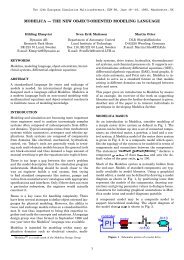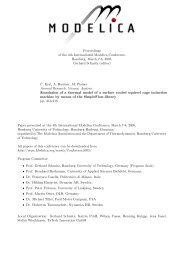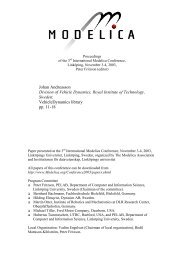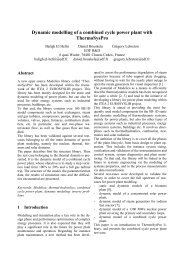Modelica'2008 Modelling of Electric Drives using freeFOClib
Modelica'2008 Modelling of Electric Drives using freeFOClib
Modelica'2008 Modelling of Electric Drives using freeFOClib
Create successful ePaper yourself
Turn your PDF publications into a flip-book with our unique Google optimized e-Paper software.
Abstract<br />
Modelica’2008<br />
<strong>Modelling</strong> <strong>of</strong> <strong>Electric</strong> <strong>Drives</strong> <strong>using</strong> ����������<br />
Dietmar Winkler Clemens Gühmann<br />
Technische Universität Berlin<br />
Chair <strong>of</strong> Electronic Measurement and Diagnostic Technology<br />
The ���������� (short for “free Field-Oriented Control<br />
library”) provides a framework for simulations <strong>of</strong><br />
electric drives with different application purposes. The<br />
library can be used to simply build a field-oriented<br />
control system for existing machine models from the<br />
Modelica Standard Library, investigate the impact <strong>of</strong><br />
electric faults (battery faults, inverter faults, machine<br />
faults) on a electric drive system, and run simulations<br />
to estimate the fuel consumption <strong>of</strong> hybrid electric vehicles.<br />
The library structure and some <strong>of</strong> its main components<br />
are presented. Simulation results <strong>of</strong> an electric<br />
fault are given as an application example <strong>of</strong> this<br />
library. The ���������� will be publicly available in<br />
Spring 2008.<br />
Keywords: Modelica, free library, electric machines,<br />
field-oriented control, fault simulation, hybrid electric<br />
vehicle<br />
1 Introduction<br />
In automotive applications the number <strong>of</strong> electric motors<br />
used is increasing rapidly. Most <strong>of</strong> them are doing<br />
their work without us – the car owners/users – actively<br />
noticing it. When a power window is still a quite obvious<br />
application for an electric motor, the active controlled<br />
throttle valve might not be. And with more and<br />
more tasks going to be performed by-wire (e.g., braking,<br />
steering) the number <strong>of</strong> electric motors used is due<br />
to increase even more. But not only small electric motors<br />
are present. With the electric motor being used<br />
for active propulsion in hybrid electric vehicles (HEV)<br />
also the power rating <strong>of</strong> motors used grows bigger.<br />
But how do all these little and large motors work together?<br />
How should the manufacturer develop the controller?<br />
What happens if there is a fault in the system?<br />
�����������������������������������������������<br />
<strong>Modelling</strong> <strong>of</strong> <strong>Electric</strong> <strong>Drives</strong> <strong>using</strong> <strong>freeFOClib</strong><br />
Will the faults cause serious damage or just minor inconveniences?<br />
All these question could be answered by <strong>using</strong> simulations<br />
to investigate the normal and faulty behaviour.<br />
For the creation <strong>of</strong> such simulation models we need<br />
both, appropriate machine models and the suitable machine<br />
controllers. The overall simulation model will<br />
contain signals from different physical domains (i.e.,<br />
electrical and mechanical).<br />
The modelling language Modelica 1 was especially developed<br />
to simplify the simulation in different physical<br />
domains in one simulation model. The multi-domain<br />
capability allows us to build simulation models <strong>of</strong> hybrid<br />
electric vehicles easier than than with other simulation<br />
tools.<br />
So far our Chair <strong>of</strong> Electronic Measurement and Diagnostic<br />
Technology has investigated different aspects <strong>of</strong><br />
Modelica with real-time applications and hybrid electric<br />
vehicles ([1, 2]).<br />
2 Purpose <strong>of</strong> the library<br />
The Modelica language is specified in the so called<br />
Modelica Specifications [3] and comes with the free<br />
Modelica Standard Library (MSL) [4] which contains<br />
a huge collection <strong>of</strong> models for different physical domains<br />
(e.g., electrical, mechanical, thermodynamical).<br />
For the simulation <strong>of</strong> machines the Modelica<br />
Standard Library contains a sub-library called<br />
���������������������������� [5]. This library<br />
contains basic three-phase models <strong>of</strong> asynchronous<br />
and synchronous machines as well as DC machine<br />
models. To control these machines the modeller still<br />
has to provide his own controllers since currently there<br />
is no free Modelica library available to provide complete<br />
electric drive models.<br />
1 Modelica R○ is a free modelling language developed by the<br />
Modelica Association → www.modelica.org<br />
The Modelica Association 215 Modelica 2008, March 3 rd − 4 th , 2008
D. Winkler, C. Gühmann<br />
So in order to simulate more complex electric drive applications<br />
a new “free Field-Oriented Control Library”<br />
(����������[6]) is being developed.<br />
3 Library structure<br />
The ���������� should allow the user to model and<br />
simulate all aspects <strong>of</strong> the an electric drive. A standard<br />
electric drive normally consist <strong>of</strong> components like<br />
power sources, power electronics, controllers, electric<br />
machines, and interfaces. The communication <strong>of</strong> the<br />
blocks can be done either via the classic approach by<br />
use <strong>of</strong> input and output connectors or by the use <strong>of</strong> bus<br />
signals. The bus structure orients itself on the new bus<br />
structure <strong>of</strong> the Vehicle Interfaces Library [7]. This<br />
should allow easier simulation <strong>of</strong> power-train simulations<br />
<strong>of</strong> hybrid electric vehicles, for example.<br />
Figure 1: Top-level packages <strong>of</strong> the <strong>freeFOClib</strong><br />
Figure 1 shows a graphical representation <strong>of</strong> the uppermost<br />
hierarchy level <strong>of</strong> the library.<br />
The library consists <strong>of</strong>:<br />
���������� Every Modelica library should contain<br />
this. It gives the user information on how to use<br />
the library as well as some information about the<br />
release history and participating developers.<br />
�������� To get the user going some example simulation<br />
models are included. There are subpackages<br />
<strong>of</strong> examples for the different parts (e.g.,<br />
complete drive systems, batteries, inverters, machines)<br />
��������� This is a sub-package that contains different<br />
battery models.<br />
���������� Models which are library-wide used and<br />
therefore do not fit exclusively into any <strong>of</strong> the<br />
other sub-packages are placed here.<br />
����������� In here controllers for the control <strong>of</strong><br />
electric drives together with the necessary flux<br />
models are placed.<br />
��������� Custom functions which are used by the<br />
����������.<br />
����� Special icons for the models.<br />
���������� The Interfaces sub-package includes<br />
different interface models. Mostly they are made<br />
<strong>of</strong> a partial type so that one can simply extend<br />
from the interface model which fits the application<br />
most.<br />
��������� These models are used to transform the<br />
control signals into electrical signals which can<br />
then be applied to the machine models.<br />
�������� This library contains models <strong>of</strong> synchronous<br />
and asynchronous machines <strong>of</strong> different<br />
types.<br />
In addition to the different controller types for the<br />
field-oriented control as well as the battery models<br />
(important for automotive applications) also new machine<br />
models for fault-simulations have been developed.<br />
These are <strong>using</strong> the m-phase presentation where<br />
the faults can be introduced directly into the components<br />
without the need <strong>of</strong> a d − q − 0-transformation<br />
(see also [8]).<br />
4 Library contents<br />
After a first quick overview <strong>of</strong> the library we like to<br />
explain some the library’s content in more detail.<br />
4.1 Batteries<br />
In the current version <strong>of</strong> the <strong>freeFOClib</strong> there are two<br />
different types <strong>of</strong> batteries present. One very simple<br />
model consisting <strong>of</strong> an internal resistor and a controlled<br />
signal voltage only. As this is normally not<br />
sufficient for more advanced simulations (e.g., simulations<br />
<strong>of</strong> driving cycles <strong>of</strong> hybrid electric vehicles)<br />
an advanced battery model was added. This model<br />
is based on models from the Advisor 2002 Simulink R○<br />
model. It contains three main sub models: ���,<br />
�������, and ���������� (see Figure 2).<br />
The advanced battery model includes an active energy<br />
management. The state <strong>of</strong> charge is calculated by ���.<br />
The simple internal resistor <strong>of</strong> the ideal resistor is replaced<br />
by a variable resistor. The value <strong>of</strong> resistance is<br />
The Modelica Association 216 Modelica 2008, March 3 rd − 4 th , 2008
Figure 2: Advanced battery model<br />
controlled by look-up tables and depends on the charging/discharging<br />
current, the state <strong>of</strong> charge, and the<br />
temperature. Currently the characteristic behaviour <strong>of</strong><br />
a Nickel-Metal-Hydrid battery type is implemented.<br />
Also included is a switch which acts as a battery protection<br />
system and is controlled by the ����������<br />
and the ��� models.<br />
4.2 Controllers<br />
This package provides models for the regulation <strong>of</strong><br />
the control variables flux, speed, torque, and current.<br />
There is a series <strong>of</strong> different control strategies. Which<br />
<strong>of</strong> these strategies is the best applicable depends on<br />
the application. In field-oriented control the used fluxmodel<br />
represents a crucial part <strong>of</strong> the controller. Depending<br />
on the machine and the operational range <strong>of</strong><br />
speed the correct flux model has to be chosen.<br />
The ���������� <strong>of</strong>fers a small variety <strong>of</strong> flux-models<br />
(see, for example, [9, 10] for more information on control<br />
<strong>of</strong> electric drives):<br />
• Current models (I − ϑ, I − ω)<br />
• Current-voltage models (UI, UI − ω)<br />
• Voltage models<br />
4.3 Inverters<br />
This sub-package contains different inverter models.<br />
For a start there is an ������������� which can be<br />
used if effects <strong>of</strong> the power electronic circuitry are not<br />
<strong>Modelling</strong> <strong>of</strong> <strong>Electric</strong> <strong>Drives</strong> <strong>using</strong> <strong>freeFOClib</strong><br />
<strong>of</strong> interest. This gives the ideal voltage and current<br />
signals and does not need much computing power.<br />
When effects <strong>of</strong> the power electronic are <strong>of</strong> interest<br />
than there are two different types <strong>of</strong> voltage controlled<br />
inverters available:<br />
Space Phasor modulation Depending on the control<br />
signal an appropriate voltage space phasor is calculated.<br />
The position <strong>of</strong> the space phasor can then<br />
be transformed into firing signals for an m-phase<br />
inverter bridge (where m could be any number <strong>of</strong><br />
phases ≥ 3).<br />
Sinus-Delta modulation Here a sin-wave signal is<br />
compared with a high-frequency triangular wave.<br />
A logic circuitry then generates the firing signals<br />
for the m-phase inverter bridge.<br />
Both non-ideal inverter types have the drawback that<br />
they need a lot <strong>of</strong> computational power. This has<br />
caused by the need to restart the numerical solver<br />
whenever an event (e.g., switch from one inverter leg<br />
to the other) is triggered.<br />
4.4 Machines<br />
Fortunately, if a modeller tries to build a<br />
standard electric drive with standard 3-phase<br />
machines he can just pick them out <strong>of</strong> the<br />
���������������������������� library. These<br />
standard machines can be used in combination with<br />
our controllers and inverters.<br />
Unfortunately, there is a restriction on the number <strong>of</strong><br />
phases (i.e. m = 3). The ���������� provides asynchronous<br />
and synchronous induction machine models<br />
for m-phases and different architectures. The subpackage<br />
for synchronous machines contains m-phase<br />
models with electrical excited and permanent magnet<br />
rotors. The sub-package for asynchronous machines<br />
contains m-phase models with squirrel-cage and slipring<br />
rotor. In each <strong>of</strong> the models the stator inductance<br />
can be changed during simulation time to investigate<br />
fault impacts.<br />
In contrast to the machine models from the Modelica<br />
Standard Library the m-phase models <strong>of</strong> the<br />
���������� are not modelled in the so called d − q −<br />
0-frame but in the m-phase system. This might seem<br />
odd since the d − q − 0-frame was actually introduced<br />
to reduce the computational demand <strong>of</strong> machine simulations.<br />
However when developing the ����������<br />
one <strong>of</strong> the requirements was to be able to simulate<br />
faults and therefore unsymmetrical systems. As soon<br />
The Modelica Association 217 Modelica 2008, March 3 rd − 4 th , 2008
D. Winkler, C. Gühmann<br />
as an electrical m-phase system becomes unsymmetrical<br />
all the computational benefit <strong>of</strong> the d −q−0 transformation<br />
is lost. More about the underlying theory <strong>of</strong><br />
the machine models can be found here [8].<br />
5 Library applications<br />
The development <strong>of</strong> the ���������� was started with<br />
specific purposes in mind:<br />
• field-oriented control <strong>of</strong> induction machines<br />
• fault-simulations to investigate electrical and mechanical<br />
impacts <strong>of</strong> machine faults<br />
• state <strong>of</strong> charge estimations for batteries in HEV<br />
applications<br />
• investigate adaptive controller algorithms for<br />
electric machines<br />
In automotive applications, for example, <strong>of</strong>ten the<br />
term drivability <strong>of</strong> a car is used. With drivability the<br />
car manufacturers <strong>of</strong>ten relate to the overall operating<br />
qualities <strong>of</strong> the power train. This could include things<br />
like idle mode characteristics, throttle response, and<br />
acceleration capability. In a hybrid electrical vehicle<br />
for example we got an electric motor acting directly or<br />
indirectly on the drive train.<br />
The ���������� contains an example model which<br />
allows for simulation <strong>of</strong> three different types <strong>of</strong> faults,<br />
i.e., faults <strong>of</strong> the battery, faults in the inverter, and<br />
faults in the machine (see Figure 4).<br />
5.1 Inverter and battery faults<br />
To simulate faults in the battery and/or in the inverter,<br />
the example model in Figure 4 contains a fuse component<br />
�������. This model disconnects the DC current<br />
when a surge current is detected that violates the maximum<br />
rating <strong>of</strong> the battery. The surge-pro<strong>of</strong> fuse is not<br />
triggered right away but after a first order delay time<br />
which can be parametrised. Whenever the fuse is triggered<br />
the inverter gets a signal which will switch <strong>of</strong><br />
the firing signals for the inverter bridge in turn.<br />
Another kind <strong>of</strong> battery fault would be a short circuit<br />
<strong>of</strong> the supply side <strong>of</strong> the inverter. This is accomplished<br />
by a simple switch that is triggered by a boolean signal<br />
and which connects both support voltage connectors <strong>of</strong><br />
the inverter.<br />
And at last a fault <strong>of</strong> firing signals can be applied directly<br />
via a signal ��������������. The combination<br />
<strong>of</strong> the different switches gives the abbility to build<br />
even more fault scenarios.<br />
5.2 Machine faults<br />
In the electric machine models <strong>of</strong> our library the following<br />
fault scenarios can be simulated:<br />
• open-circuit <strong>of</strong> a stator phase (e.g., a connecting<br />
cable is broken)<br />
• short-circuit phase to ground (e.g., insulation failure<br />
because <strong>of</strong> mechanical damage)<br />
• short-circuit <strong>of</strong> one or more phase windings (e.g.,<br />
insulation failure because <strong>of</strong> thermal stress within<br />
the stator or rotor)<br />
Each <strong>of</strong> these faults will have some influence <strong>of</strong> the<br />
torque produced by the electric drive.<br />
5.2.1 Short-circuit phase to ground<br />
In Figure 3 you can see the simulation results <strong>of</strong> a synchronous<br />
machine with an electric excited rotor. At<br />
the time <strong>of</strong> T = 2sec one stator phase is connected to<br />
ground. The figure shows all three phase currents and<br />
the mechanical torque over time.<br />
200<br />
100<br />
T[Nm]<br />
i[A]<br />
0<br />
-100<br />
200<br />
100<br />
0<br />
-100<br />
-200<br />
Torque<br />
1.6 1.8 2 2.2 2.4 2.6<br />
Time[s]<br />
Currents<br />
1.6 1.8 2 2.2 2.4 2.6<br />
Time[s]<br />
Figure 3: Fault scenario: short-circuit <strong>of</strong> one stator<br />
phase to ground<br />
At the beginning the electric machine runs at a constant<br />
speed and with a constant load torque applied<br />
to the shaft end. When the short-circuit occurs the<br />
controller tries to keep the torque at a constant level<br />
but can only do so for a certain amount <strong>of</strong> time until<br />
the fuse finally gets triggered because <strong>of</strong> over-current.<br />
With such kind <strong>of</strong> simulation model one could for<br />
example try to find the optimum kind <strong>of</strong> fuse which<br />
The Modelica Association 218 Modelica 2008, March 3 rd − 4 th , 2008
is sluggish enough to withstand short power surges<br />
whilst still protecting the drive’s power electronic.<br />
5.2.2 Short-circuit within a phase winding<br />
In Figure 5 a fault <strong>of</strong> the insulation between the phase<br />
windings <strong>of</strong> a stator coil is modelled. Such a fault can<br />
be caused by, for example, over-temperature or overload<br />
which in turn leads to an overheated stator winding.<br />
This behaviour is modelled by reducing the inductance<br />
value abruptly by 20 percent. In Figure 5 you can<br />
see the three phase currents and the mechanical torque<br />
over time just before and after the connection <strong>of</strong> one<br />
phase was opened at the time <strong>of</strong> T = 2sec.<br />
At first sight the electrical impact seems not to be very<br />
drastic. However since the field-oriented control now<br />
calculates the wrong control values the torque starts<br />
to oscillate quite considerable. If this electric drive is<br />
applied in a hybrid electric vehicle, for example, this<br />
could lead to reduction <strong>of</strong> drive comfort. But not only<br />
this, depending on the mechanical system such oscillation<br />
could become unstable and cause major damage.<br />
5.3 Field-oriented control loop<br />
Having a variety <strong>of</strong> different flux-models available allows<br />
the modeller to investigate different kind <strong>of</strong> control<br />
strategies for electric drives. So for example by<br />
varying some <strong>of</strong> the controllers parameters (e.g., the<br />
machine rotor resistance) one can test how robust the<br />
drive control behaves at a certain rotor speed when <strong>using</strong><br />
different flux-models for the estimation <strong>of</strong> the flux<br />
position.<br />
Figure 4: Example model <strong>of</strong> an electric drive system.<br />
80<br />
70<br />
60<br />
50<br />
40<br />
T[Nm]<br />
30<br />
20<br />
10<br />
0<br />
100<br />
50<br />
i[A] 0<br />
-50<br />
-100<br />
<strong>Modelling</strong> <strong>of</strong> <strong>Electric</strong> <strong>Drives</strong> <strong>using</strong> <strong>freeFOClib</strong><br />
Torque<br />
2 2.5 3 3.5 4 4.5 5<br />
Time[s]<br />
Currents<br />
2 2.5 3 3.5 4 4.5 5<br />
Time[s]<br />
Figure 5: Fault scenario: short-circuit <strong>of</strong> phase windings<br />
6 Future work<br />
The main task for the future is the extension <strong>of</strong> the<br />
����������. Here is a short collection <strong>of</strong> ideas we<br />
are currently having:<br />
• further clean up <strong>of</strong> the structure so that the usage<br />
is more intuitive<br />
• add more controller types which allow also the<br />
investigation <strong>of</strong> different control architecture not<br />
just pure parameter variations<br />
• enhance battery models with temperature models<br />
The Modelica Association 219 Modelica 2008, March 3 rd − 4 th , 2008
D. Winkler, C. Gühmann<br />
(at the moment only look-up tables are used to<br />
calculate the resistance)<br />
• verification <strong>of</strong> machine models<br />
• investigate simplifications to make the machine<br />
and inverter models real-time capable<br />
A pure estimate <strong>of</strong> the simulated values might give<br />
some clues on the general behaviour during faults.<br />
However to actually use the simulation to gain useful<br />
information (e.g., for programming a controller for<br />
the power electronics) we need more than just estimates.<br />
So the simulation model has to be verified by<br />
doing real measurements <strong>using</strong> a real electric motor.<br />
It is planned to set up test-bench system consisting <strong>of</strong><br />
a asynchronous induction machine <strong>of</strong> from currently<br />
available hybrid electric vehicle and an electric load<br />
machine.<br />
The first public <strong>of</strong>ficial (pre)release is due in spring <strong>of</strong><br />
2008. There will be a public development repository<br />
available. For any news on the ���������� see ����<br />
��������������. On that site a mailing-list is also<br />
available to keep you up to date automatically.<br />
7 Acknowledgements<br />
We hereby like to acknowledge that a lot <strong>of</strong> work on<br />
the library was done by students as part <strong>of</strong> their student<br />
research projects:<br />
• Stefan Rinderer, “Development <strong>of</strong> a Modelica Library<br />
for the Field-Oriented Control <strong>of</strong> <strong>Electric</strong><br />
Machines”, student research project, supervisor:<br />
Dietmar Winkler, Chair <strong>of</strong> Electronic Measurement<br />
and Diagnostic Technology, TU Berlin, 16 th<br />
April 2007<br />
• Eduard Bakhach and Florian Döring, “<strong>Modelling</strong><br />
<strong>of</strong> a Field-Oriented Synchronous Inductionn Machine<br />
with Modelica”, student research project,<br />
supervisor: Dietmar Winkler, Chair <strong>of</strong> Electronic<br />
Measurement and Diagnostic Technology, TU<br />
Berlin, 31 st August 2007<br />
References<br />
[1] D. Winkler and C. Gühmann, “Synchronising a<br />
Modelica Real-Time Simulation Model with a<br />
Highly Dynamic Engine Test-Bench System,” in<br />
5th International Modelica Conference (D. C.<br />
Kral and A. Haumer, eds.), vol. 1, (Vienna),<br />
pp. 275–281, Modelica Association, arsenal research,<br />
4-5 Sep 2006.<br />
[2] D. Winkler and C. Gühmann, “Hardware-in-the-<br />
Loop simulation <strong>of</strong> a hybrid electric vehicle <strong>using</strong><br />
Modelica/Dymola,” in The 22nd International<br />
Battery, Hybrid and Fuel Cell <strong>Electric</strong> Vehicle<br />
Symposium & Exposition (E. . Secretariat,<br />
ed.), (Yokohama, Japan), pp. 1054–1063, EVS,<br />
Japan Automobile Research Institute, 23-28 October<br />
2006.<br />
[3] Modelica Association, Modelica R○ – A Unified<br />
Object-Oriented Language for Physical Systems<br />
Modeling – Language Specification, version<br />
3.0 ed., 5th September 2007.<br />
[4] Modelica Association, Modelica R○ - Free library<br />
from the Modelica Association, version 3.0 ed.,<br />
2008.<br />
[5] C. Kral and A. Haumer, “Modelica libraries for<br />
dc machines, three phase and polyphase machines,”<br />
in Proceedings <strong>of</strong> the 4th International<br />
Modelica Conference (G. Schmitz, ed.), pp. 549–<br />
558, Modelica Association, March 7-8 2005.<br />
[6] D. Winkler, E. Bakhach, F. Döring, and<br />
S. Rinderer, “���������� - A free Field-<br />
Oriented Control library for Modelica.” unreleased,<br />
see ������������������ for any news.<br />
Due in, Spring 2008.<br />
[7] M. Dempsey, M. Gäfert, P. Harman, C. Kral,<br />
M. Otter, and P. Treffinger, “Coordinated Automotive<br />
Libraries for Vehicle System <strong>Modelling</strong>,”<br />
in Proceedings <strong>of</strong> the 5th International Modelica<br />
Conference (D. C. Kral and A. Haumer, eds.),<br />
vol. 1, (Vienna), pp. 33–41, Modelica Association,<br />
arsenal research, September 2006.<br />
[8] D. Winkler and C. Gühmann, “<strong>Modelling</strong> <strong>of</strong><br />
<strong>Electric</strong>al Faults Using Modelica,” in Proceedings<br />
<strong>of</strong> ’The 48th Scandinavian Conference on<br />
Simulation and Modeling (SIMS 2007)’, Scandinavian<br />
Simulation Society, 30th - 31st October<br />
2007.<br />
[9] W. Leonhard, Control <strong>of</strong> <strong>Electric</strong>al <strong>Drives</strong>.<br />
Springer, 3rd ed., 2001.<br />
[10] D. Novotny and T. Lipo, Vector Control and Dynamics<br />
<strong>of</strong> AC <strong>Drives</strong>. Clarendon Press Oxford,<br />
1996.<br />
The Modelica Association 220 Modelica 2008, March 3 rd − 4 th , 2008

















